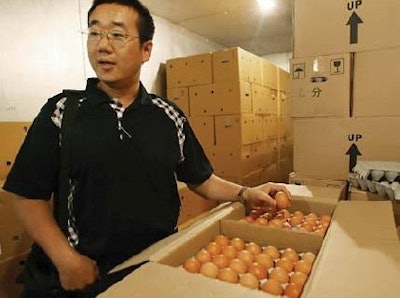
By 2015, world egg consumption is expected to have increased from its current 60 million metric tons to 70 million tons, and 70% of this increase is forecast to occur in Asia.
In 1970, hen egg production in Asia stood at 4.6 million tons, making the region the third most important globally, behind Europe and the Americas. At that time, world output amounted to only 19.5 million tons.
Since then, production in the region has rocketed by more than 700% to exceed 38 million tons in 2007, representing 61% of global output, currently estimated by the FAO at 62.6 million tonnes
Despite this growth, the egg processing industry in Asia is still in its infancy. There are approximately 110 egg product factories in the region, most of them in Japan. However, many are small liquid plants servicing the local food industry, operating within the limits permitted by local infrastructure.
While far from uniform, the region is advancing economically, with a consequent improvement in diet, and growing demand for processed products.
China
China is the region's largest egg producer and consumer. The country's egg production recorded only slow growth during the 1970s and up to the mid-80s, however, since then, expansion has been rapid.
Food safety has been top of the Chinese government's list of priorities. Stricter food processing regulations are required across the board and, once implemented, should benefit the egg processing industry. Melamine, which had been found in a variety of Chinese products, also turned up in eggs and egg products during 2008.
The egg products industry in China comprises some 16 plants, with five or six meeting international standards. The country's combined capacity to process eggs is in the region of 100,000 tons per annum.
The price of shell eggs in the country reached its highest level for five years in 2008. Nevertheless, producers are still thought to be losing money due the higher prices of energy, labour and feed.
Japan
Shell egg prices in Japan were stronger in 2008 than in 2007. Production took off in March and April and, as 2008 drew to a close, the prospect emerged of record output and record prices.
The country remains the region's main egg products importer and, despite higher import prices in 2008, at 7,760 million tons, imports over the first half of 2008 were on a par with the same period the year before.
Among Asian producers, India and China are Japan's main suppliers of egg powder. Their exports to the country in 2007 were some 3,000 tons, or 20% of powder imports. In 2007, Japan imported 800 tons of powder and 1,000 tons of frozen eggs from China alone.
Japan looks to the Netherlands to be its major supplier of egg white powder, while the USA is its primary source for whole egg and yolk powder. Japan is by far the dominant country in the region for the consumption of egg powder, consuming some 16,000 million tons.
The country also has the largest number of egg breaking facilities, some 60-65 of the region's 110.
India
India has been experiencing unusually high egg prices. The market has been characterised by reduced output and higher prices coupled with growing demand.
The laying flock is now considerably smaller than some 12 months ago, while a doubling of feed prices and poor weather have contributed to price increases.
Heavy rains in the southern egg producing states have devastated production, but India has also been hit hard by the Middle Eastern ban on its products, implemented in response to the West Bengal avian influenza outbreak in January 2008.
India's egg products industry relies almost completely on exports of egg powder, with the main markets being Europe and Japan. The industry has existed for some 10 years and is dominated by three companies with a combined powder output of approximately 10,000 tons.
Thailand
Thai egg producers have also been suffering from over supply, resulting in eggs being sold at below production cost. Producers faced the added difficulty in 2008 that the Thai animal feed committee allowed feed prices to increase by 10-20 percent in response to pressure from feed producers,
Over 90% of Thai exports of fresh eggs go to Hong Kong. With only one egg products plant, this is a sector that has great growth potential
Korea
South Korea has 14 liquid egg product factories with a combined breaking capacity of 100,000 tons of eggs per annum. The country imported some 900 tons of egg powder in 2007, of which egg white powder accounted for about half. During the first six months of 2008, imports fell due to higher prices.
The Philippines
Egg producers in The Philippines had a difficult 2008, with farmers starting to record losses in January due to over supply and high production costs. As in other countries, feed prices were higher, with the result that farm gate prices were lower than production costs.
To ease the situation, producers agreed to cull old layers, and a quota was implemented to reduce imports of breeding stock. Egg prices started to rise towards the end of the year and 2009 is expected to be slightly easier.
There is no egg products industry in The Philippines, and there is little import of products.
Higher levels of disposable income, coupled with a population drift from rural to urban areas, is changing what and how the Asian population eats. With ample egg supplies, and investment in infrastructure, Asia can be expected to account for a growing share of the global egg processing market.


















